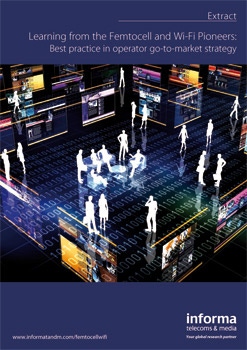Small cells still raising more questions than answers
Small cells promise to boost capacity and throughput in areas of high usage more cheaply than macro cell deployments, while allowing more efficient use of spectrum than macros, and providing improved coverage at the cell edge and indoors. Bringing the radio signal closer to the user should also help to improve device battery life.
October 24, 2011

By Julian Bright
Small cells promise to boost capacity and throughput in areas of high usage more cheaply than macro cell deployments, while allowing more efficient use of spectrum than macros, and providing improved coverage at the cell edge and indoors. Bringing the radio signal closer to the user should also help to improve device battery life.
All of the major infrastructure vendors have announced some degree of support for small cells in their product portfolios, be it picocell, femtocell, small-cell RAN, wifi or a combination of these. But far from being purely vendor driven, the need to rethink the macro model is getting equally strong support from mobile operators, many of whom have already embraced small cells through their growing use of alternative technologies such as wireless LANs and femtocells as a means of offloading data traffic from the cellular network or extending coverage.
Judging by the deliberations at Informa Telecoms & Media’s Small Cells World Congress in Berlin (October 11-12) a consensus already exists that adherence to the macro-cell network model cannot in itself provide sufficient capacity to meet future traffic demand. But that doesn’t make small cells a done deal, and it was clear that there are more questions than answers when it comes to implementing a small cell strategy.
Key areas of concern for the delegates in Berlin included how to make the best choice of small cell technology, tackling interference issues, hotspot identification (in order to better target small cell deployments), backhaul provision, managing small cells in a multi-vendor environment, handover between the macro network and small cell sites, self-organizing capabilities (SONs), and the challenges of distributed architectures and cloud-RAN.
Wifi/femtocell convergence
Wifi remains very much on the agenda for many mobile operators, but there was a clear desire to integrate the technology more closely with cellular both in terms of ease of use (network discovery, authentication and log-on) and at the core network level. Femtocells were generally agreed to have fewer integration challenges in terms of authentication and security than wifi, but interference problems between what some regarded as “unplanned” consumer femtocell deployments and the macro network remained a concern for some operators, notably Deutsche Telekom and Orange.
Vodafone, on the other hand, reported a largely positive experience with its consumer femtocell offering, which it has now launched in twelve markets including most recently the Czech Republic and the Netherlands. Despite having been deployed initially to improve voice coverage, the operator said that femtos were also having the effect of driving up data usage and reducing churn. Vodafone is already extending femtocells into the enterprise and evolving the technology for outdoor networks, and says that femtocells will feature as part of a future LTE rollout.
Most speakers, Vodafone included, subscribed to the now widely shared view that femtocells and wifi can be complementary. With the majority of today’s femtocell deployments addressing voice coverage, some operators remain unconvinced that the technology can provide a viable platform for data. However, there was broad agreement that achieving a greater degree of harmonization between femtocells and wifi could exploit the strengths of both technologies while minimizing concerns about their perceived shortcomings.
The news that industry bodies including the Femto Forum, the Wi-Fi Alliance and the Wireless Broadband Association are co-operating shows that old rivalries have clearly been buried. For its part, the Femto Forum envisages a new balance between Wi-Fi and femtocell usage in a smart combination to provide “fine-grained offload” and a better customer experience.
One practical application of femtocell/wifi convergence was recently demonstrated by combining the femtocell’s SIM-based authentication and billing capabilities with wifi as a delivery mechanism for high-volume data such as video content. The introduction of integrated femtocell/wifi access points such as Contela’s product for Korea’s SKT (co-developed with Picochip) is further evidence that the technologies are converging, and in Berlin Huawei confirmed that it now has a commercial, integrated femtocell/wifi product for providing improved coverage and latency for in-building systems.
Outstanding issues
The “to do” list for small cells to be successful is extensive, however, particularly with regard to integration with the macro level. Initially this means improved radio planning, simplified field installation and set-up, and smarter handover and cell-load management. Also under discussion were the implementation of QoS and policy management in small cell networks , and support for multi-vendor heterogeneous-network.
Some of these areas will be addressed through the use of self-organizing networks (SONs), for example, by providing the capability for newly-installed cells to self-configure and self-optimize in relation to neighbouring cells and the prevailing radio environment. In the heterogeneous network, SON support within a multi-vendor small cell environment will be crucial.
Network Norway, which is already using SONs as part of its enterprise femtocell offering, says these capabilities can also be applied in public (outdoor) small-cell networks. Deutsche Telekom wants to extend SON functionality to provide the option of powering down small cell sites during periods of low usage such as overnight.
Alcatel-Lucent called for greater flexibility in the management of handover between the macro and small cells within its coverage area, pointing out that incoming handover to the hotspot would not be necessary in cases where the user was passing through the small cell area and could be retained on the macro network. This would require fewer limitations on the definition of target cells as contained in the current standards, the vendor argued.
Several speakers also agreed that the accurate pinpointing of hotspots – down to 50 metres – was an important requirement that the industry needs to address.
Hetnets & Cloud RAN
The goal of the truly heterogeneous network where multiple small cell technologies provide seamless layers of coverage within the macro environment may be some way off, but vendors speaking in Berlin were keen to outline the advantages of a coordinated approach in maximising the potential capacity and performance gains.
Huawei pointed to improvements in cell throughput in excess of four times that of the macro, that could be achieved with effective interference coordination in hetnets, while Alcatel-Lucent presented examples of performance gains achievable with the densification of small cells, and talked of the importance of load balancing between cells, and precision small-cell deployment. Modelling by Bellabs showed a potential TCO saving of up to 55 per cent over 5-years for a small cell deployment versus the macrocell alternative
From the operator side, Deutsche Telekom stressed the need for policy management capabilities to be implemented on a local basis, and said that the tools were coming for operators to implement policy in hetnets.
Speakers and delegates alike were cautious on the subject of Cloud RAN architectures that separate the remote radio head and antenna from the cell’s baseband processing functionality. One major concern related to backhaul, or more specifically the challenge of supporting so-called “fronthauling” between the baseband pool and the remote radio unit.
Deutsche Telekom said that while current trials of a Cloud RAN solution in China would benefit from the availability of fibre, its own situation was different, and it lacked the ability to provide “endless capacity”. Hence the operator is looking for a “middle way” somewhere between a cloud RAN and a BTS-on-a-mast approach.
Read more about:
DiscussionYou May Also Like






.png?width=300&auto=webp&quality=80&disable=upscale)


_1.jpg?width=300&auto=webp&quality=80&disable=upscale)


.png?width=800&auto=webp&quality=80&disable=upscale)